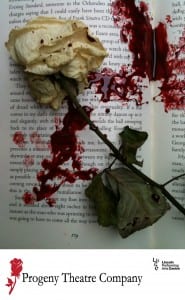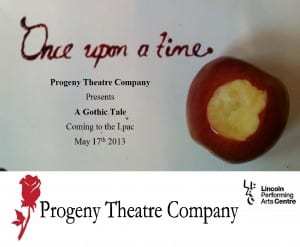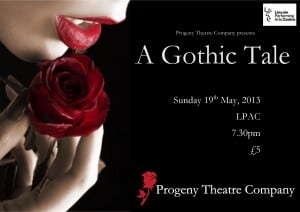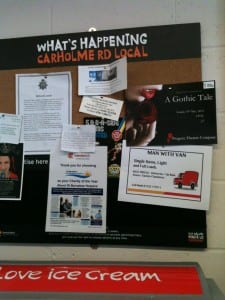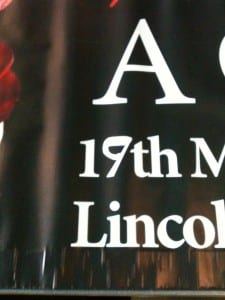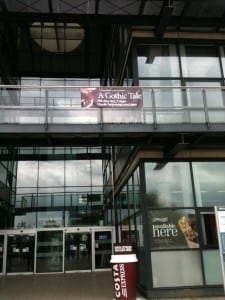I have recently discovered a company named Playbox Theatre who, in 2010, produced and adaptation of Angela Carter’s The Bloody Chamber. Matthew Finch states that Playbox were “blurring the transition from everyday life to a darker fairytale world” (2010). Although this is similar to what we were doing with A Gothic Tale, as we were showing the reality of what happened after the ‘happily ever after’ – in between the dream scenes, our performances differed drastically. Where their production was based on Bluebeard, ours incorporated Bluebeard and The Snow Child. We also added certain characters such as the Ex-Wife and the House Keeper. Finch later goes on to say, “in the opening dance, a suited man – the malevolent husband of the protagonist – moved among the girls, posing them, dancing with them, tearing out their hearts in his search for the perfect woman” (2010). Their ending was completely different too. A Gothic Tale ended with a series of twists including Elizabeth (The Countess) accidentally killing William (The Blind Piano Tuner), then with the reveal of the newly dead Ex-Wife , then Elizabeth killing the Count (on her second attempt) and finally with the House Keeper locking her in the bloody chamber. Playbox’s production ended with the Countess blinding herself with the key to the bloody chamber:
The original’s happily-ever-after conclusion is replaced by an extended sequence derived from Carter’s vampiric Lady of the House of Love. The widowed bride blinds herself with the key to her husband’s chamber and attacks the women’s magazines that litter the stage with their incessant bombardment of words and images. She feasts on stolen hearts…before turning on her new lover to quote her husband’s ominous words: ‘This is the key that leads to the kingdom of the unimaginable.’
(Finch, 2010).
Despite these differences, some elements where the same as they are based on the same story. For instance, the necklace given to the Countess, in both productions, where made of red ribbon to symbolise a slit on her neck.
Playbox were founded in 1986 and they work closely with young people,
It exists to provide young people and developing artists a unique environment for training, creation and exploration in theatre and related artistic forms.
Playbox believes passionately in the evolution of a strong artistic network regardless of age, experience, social, religious and cultural backgrounds.
Throughout the year Playbox Theatre offers a wide range of programmes and activities for young people to learn and develop skills across the arts.
(Playbox Theatre 2012).
Being a highly established company their marketing differs to ours. However, like Progeny Theatre Company, they do have a Twitter account and a Facebook page. Their Twitter account is used in the same way as ours. They use it to keep their followers informed about upcoming performances and to make announcements about their company in general. They also notify their followers about involvement opportunities within their company. With them being a well-known professional company, they do have more followers than we do. They have 944 where as we have 167.
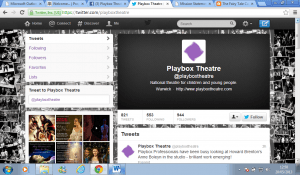
(Playbox Theatre’s Twitter account)
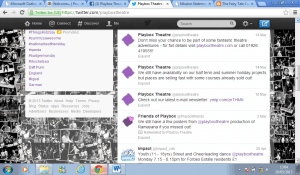
(Playbox Theatre’s Twitter account)
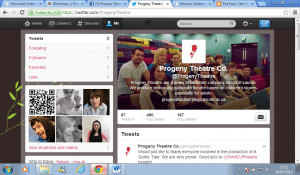
(Progeny Theatre Company’s Twitter account)
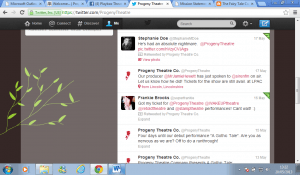
(Progeny Theatre Company’s Twitter account)
Playbox use Facebook to document the process of their productions and to give their audience sneak previews, as do we. We use our Facebook page in many of the same ways in which Playbox Theatre do. We have rehearsal photos, promotional videos and events, including the event of our show. We each have and ‘about’ section which include our mission statements. However, Playbox Theatre also have a small history of their company and directions to their headquarters, The Dream Factory. These are things that are impossible for us to have as we are not an established company. Although I do feel that we create more engagement with our audience due to the things such as competitions that we hold. This allows us to interact more with our audience. Again they obviously have more likes than us. They have 1,179 likes where as we currently have 233 likes.
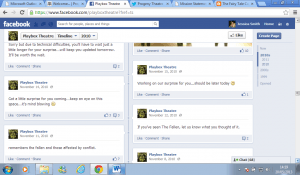
(Playbox Theatre)
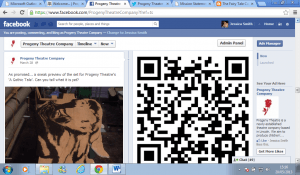
(Progeny Theatre Company)
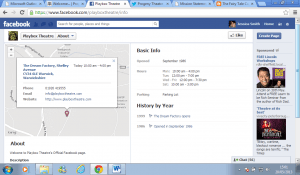
(Playbox Theatre’s Facebook page)
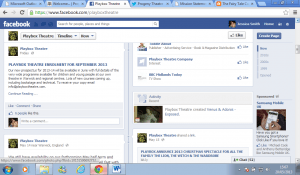
(Playbox Theatre’s Facebook page)
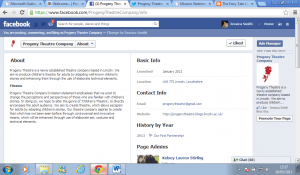
(Progeny Theatre Company’s Facebook page)
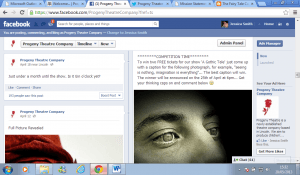
(Progeny Theatre Company’s Facebook page)
Word Count: 689
Works Cited
Finch, Matthew (2010) Guest Post: Matthew Finch on Playbox Theatre’s ‘The Bloody Chamber’. Online:
http://thefairytalecupboard.blogspot.co.uk/2010/05/guest-post-matthew-finch-on-playbox.html [accessed 16th May 2013].
Playbox Theatre (2012) Mission Statement. Online:
http://www.playboxtheatre.com/aboutus/Mission_Statement.html [accessed 16th May 2013].










